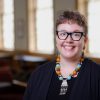This article is more than 5 years old.
On Friday, May 11, 2012, nearly one year after hearing concluding arguments in the trial of the 2008 lawsuit brought against Georgia State University by three scholarly presses, Oxford U. Press, Cambridge U. Press and SAGE (funded by the Copyright Clearance Center and the Association of American Publishers), Judge Orinda Evans issued her opinion. As detailed in her 350 page analysis, the defendants clearly prevailed, with Judge Evans finding only 5 instances of infringement out of 99 (only 75 were actually submitted as evidence at trial), amounting to $750 in lost royalties. News is mostly good for libraries looking at this decision for guidance on their own e-reserves practices, although there are a few frustrations.
Fair use determinations came down to the third and fourth factors (amount used and market impact, respectively), as the first two factors favor libraries nearly every time. Under factor three, one of the frustrations is the use of a bright line rule for determining an appropriate amount: 10% of a text with 10 or fewer chapters, or up to 1 chapter of a text with 10+ chapters, assuming that neither amount is the “heart of the work.” This is less flexible than desired, but the silver lining is that Judge Evans rejected the publishers’ assertion that the 10% should only be factored from the text, excluding acknowledgements, introductions, indexes, etc; she followed GSU’s determination of 10% of the work in its entirety. Also, even if an excerpt exceeded 10%, the use may still be fair, depending on the fourth factor.
The fourth factor of fair use assesses market impact, or harm, and in instances where there is a readily available and reasonably priced license for digital excerpts, then the use cannot be fair. Although reasonably priced is not defined (another frustration), Judge Evans was explicit that the readily available license must specifically allow for digital excerpts; if publishers try to force a license for the whole work, then fair use remains a possibility. How publishers will respond with future licensing remains to be seen, but to some this is a victory for the Copyright Clearance Center, as they will have more leverage in enticing publishers to participate in CCC licensing options offered to academic libraries.
Two clear victories for libraries pertain to the third factor of fair use determination: 1) Judge Evans rejected the publishers’ claim that the 1976 Classroom Guidelines should define the maximum amount of allowable copying; and, 2) the court rejected the idea that using the same excerpt for more than one semester somehow makes the use no longer fair–Judge Evans called this “an impractical, unnecessary limitation.”
Below are links to news articles and commentary on the decision, and I especially call your attention to those that are asterisked **. To learn more about the GSU decision and implications for e-reserves at Wake Forest, join me for a discussion of the case on Tuesday, June 12 at 10am. Register at https://pdc.wfu.edu/event/4882/.
News Articles
- Long-Awaited Ruling in Copyright Case Mostly Favors Georgia State U. – The Chronicle of Higher Education – May 13
- Some Leeway, Some Limits – Inside Higher Ed – May 14
- Publishers and Georgia State See Broad Implications in Copyright Ruling – The Chronicle – May 14
- Judge Delivers Mixed Verdict in GSU E-reserves Case – Publishers Weekly – May 14
- E-Reservations – Inside Higher Ed – May 15
- ** Georgia State Copyright Case: What You Need to Know–and What It Means for E-Reserves – LibraryJournal – May 17
Commentary
- ** The GSU decision–not an easy road for anyone – Scholarly Communications @ Duke blog – May 12
- The GSU E-Reserves Decision: First Thoughts – Library Babel Fish blog – May 13
- ** Inside the Georgia State Opinion – The Laboratorium – May 13
- ** ARL Issue Brief: GSU Fair Use Decision Recap and Implications – ARL – May 15
